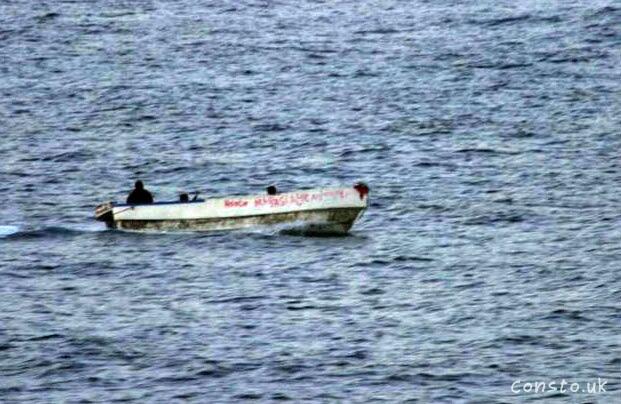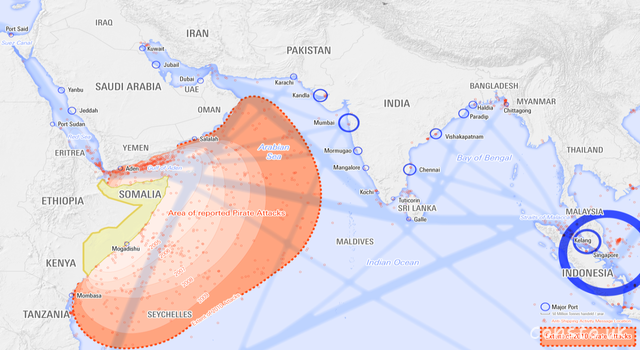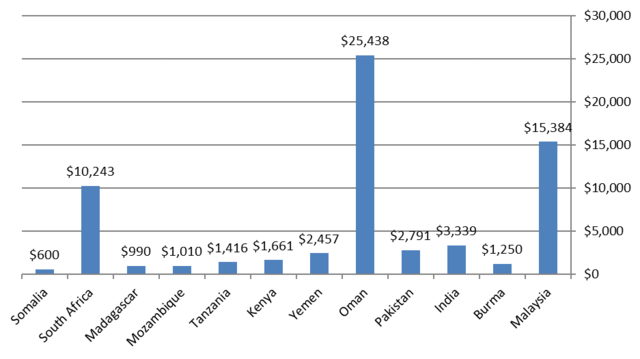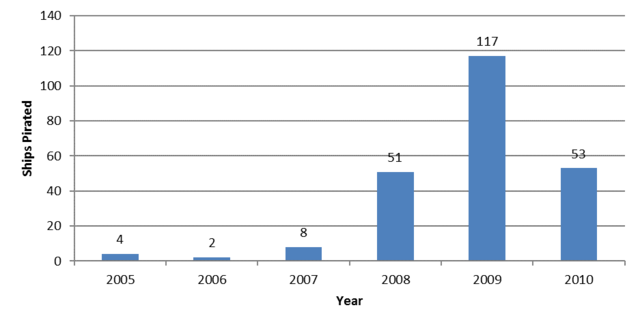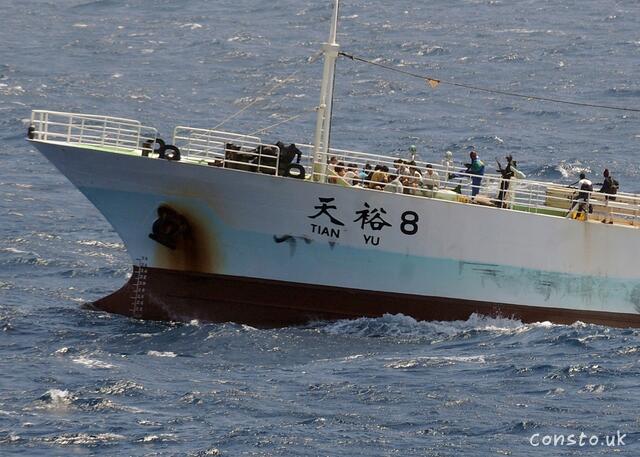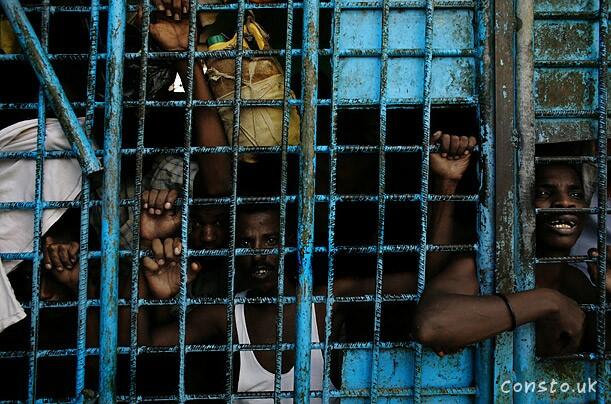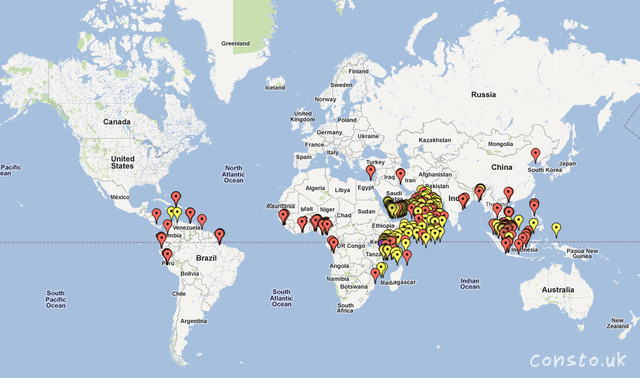Piracy in the Indian Ocean Nov. 3, 2011 in Geography, Text
The coastline around the country of Somalia is full of people committing acts of piracy and holding people hostage for a ransom. These are not pirates like you see in films but rather 20-35 year old Somalians with speedboats, GPS and modern guns. They attack cruise liners, oil tankers, fishing vessels and any other boat which they think they are capable of capturing. I am going to attempt to look for the reasons why high levels of piracy are taking place in the area and then why it is such a problem for people who need to travel or transport good by sea. To start will research Somalia then other aspects to work out why pirates have been such a problem in the Indian Ocean.
I believe that the reason pirates have been such a problem is because Somalia is a failed state and consequently very poor, turning people with boats into pirates due to the money involved.
A group of 12 pirates who later fired on a ship in the American Navy
Somalia’s Geography
Somalia is located in the Horn of Africa with Ethiopia to the west and Kenya to the south-west. It is next to the Indian Ocean and the Red Sea; due to this it has the longest Coastline for a country in Africa. In the north of the country is a desert which in the rainy season is full of lush vegetation and mountains, because of this there is plateau for the central part of the country which is important for livestock grazing. Above is a map showing the extent of piracy in the Indian Ocean, in the map you can clearly see that every year the area of reported piracy attacks increases due to boats avoiding the coastline to protect themselves from the pirates.
Somalia’s History
In 1991 Somalia was divided by civil war, as a result of this there is no central government which controls the country and is one of the most violent and poorest countries in the world and because of this many people regard Somalia as a failed state with life expectancies as low as 48 years for men and 51 years for women. In addition to this the country is also encountering a drought resulting in a humanitarian crisis which in turn has driven many Somalians to commit acts of piracy in order to survive.
The Somalian Civil War started in 1991 as a result of the country’s dictator Siad Barre started attacking clan groups who opposed his rule. The violence ballooned and destabilised the communist state resulting in the mess Somalia is in today. It started as a result of clashes between various clans but in the mid-2000’s militant Islamists started fighting as well. Due to all of this in 2009 the Somalian government declared a state of emergency and requested military help from its neighbouring African countries to hopefully put an end to the conflict which had gripped the country.
In 1992 the UN created UNOSOM I with the mission to provide aid and restore order to the failed state of Somalia. They arrived in 1993 and started a campaign to stop the famine which was caused by the Civil War. In the two years that they operated in Somalia there were various attacks at them resulting in casualties resulting with them deciding to withdraw 2 years later in 1995.
In 2004 the Transitional Federal Government was set up to govern the country, unfortunately the country was too chaotic at the time. Several UN representatives have referred to the murder of civilians as genocide.
In recent years, Somalia is in a drought with high fuel, food and water prices. This has caused piracy to increase hugely from with people taking part from many fishing towns. In 2008 the government created the Maritime Security Patrol Area in the Gulf of Aden with the aim to reduce piracy; as a result of this, leaders have been caught and piracy in the area is only a third of what it was a year ago, unfortunately attacks in other parts of the ocean have increased due to some pirates just shifting where they are operating.
This picture shows several pictures of Somalian pirates and the weapons such as RPGs, assault rifles and various others that they use while trying to capture a ship which they hope to get a ransom from.
GDP in the Indian Ocean
This graph is the GDP per capita PPP of various countries in the Indian Ocean. Out of all of the countries Somalia was the poorest with on $660 and the oil rich nation of Oman the richest ($25,438) with the relatively strong economies of South Africa ($10,243) and Malaysia ($15,384) in the middle.
Ships Attacked by Somalia Pirates
This graph shows how many ships were pirated every year since 2005 by Somalian Pirates, there was a dramatic increase in 2008 and it doubles in 2009 to 117 ships. Due to the raising levels of piracy all but essential travel is not recommended and the UN decided that Europe needed to pay a more significant role in fighting piracy which may have resulted in levels of piracy lowering in 2010.
An Attack in Progress
This Chinese fishing vessel is being pirated of the coast of Somalia; the pirates are armed and are forcing the fishermen sit on deck until they reach land where they will be almost certainly held hostage.
Impact of Piracy
This ship was destroyed by a fire which broke out when the Indian Navy fired back at pirates.
Piracy around Somalia is costing trade up to $12 billion a year as a result insurance premiums have raised significantly resulting in larger profits for the insurers. In addition as the main aim for pirating ships is to get a ransom for sending the crew, cargo and ship back due to the value of these things ransoms can be in excess of $200 million. In addition it is resulting in companies choosing not to use the Suez Canal to transport goods.
Pirates have also captured many yachts and scientific boats and ships carrying aid for humanitarian disasters which as a result will kill far more people than the 62 people who have been murdered by the pirates while being held hostage as well as the hundreds of seafarers abused and traumatized.
Reasons for Piracy
Pirates have several reasons of why they choose to pirate ships the main one being money however some pirates have claimed other reasons such as illegal fishing which is estimated to take over $300 million of fish taken each year depleting stocks and the dumping of possibly toxic waste into the waters by front companies for the Italian Mafia. Deceased Libyan dictator Muammar al-Gaddafi believed that piracy “is a response to greedy Western nations, who invade and exploit Somalia’s water resources illegally. It is not piracy, it is self-defense.” These factors are often not reported by Western press; however, in my opinion it does not excuse these crimes which accounted for 44% of all pirate attacks in the first 9 months of 2010.
The growth in countries such as India, China, Malaysia and other developed or developing countries has made turning pirate even more rewarding for Somalians. This is due to most manufactured goods being produced in countries like China and then just shipped to where they will be used. As you can see several of the world’s busiest shipping routes travel right next to or close enough for Somalian pirates to attack them.
What can be Done?
Well believe it or not, there are quite a few options which either are being acted out or could work out. Currently, one of the most widespread solutions is to either arm ships traveling through the troubled region or to escort them. This solution is far from ideal as it requires constantly paying for protection or avoiding the region which makes shipping more expensive.
Adding more international pressure and trade sanctions would also be a viable option, however, with the country divided and with no single government in charge this makes this option ineffective and therefore not really suitable.
Not paying ransoms would eventually bring hostage taking to an end as Somalian pirates wouldn’t be able to make money from them. But, piracy would likely continue in one shape or form with the goods being sold and, as keeping hostages being proved unprofitable, people would likely be killed resulting in expensive law suits along with other, major issues for the shipping company. Raiding pirate bases is currently going on and it unfortunately hasn’t had much of an impact on piracy.
In my opinion, the only true way of truly effecting piracy is to form a functional Somalian government. With a functional government, international negotiation would help to end waste dumping and illegal overfishing which, along with the economic issues related to war, originally drove many Somalians to piracy in the first place. It would also be easier with a country united, to punish Somalians who are pirating.
What is Being Done?
Somalian Pirates when caught face very different punishments for their crimes depending upon who are their captors. In Somalia they can face spending time in overheating jails until their trial and then they are faced with the possibility of the death penalty depending on the severity of their crimes. If they are caught in countries such as France, they face a much lighter crime, being sent to jail. In addition they will not be sent to Somalia as they could face the death penalty.
Why are Somalian Pirates notable?
This is a map showing all of the attacks on ships during 2010 in the entire world. Red pins are successful attacks, yellow pins are failed attacks. As you can see there are 4 main areas of Piracy. The North of South America and the West Coast of Africa which are relatively calm then Malaysia which there are far more attacks and the area with by far the most pirate attacks is around the Coast of Somalia. It also is the area with the most failed Pirate attacks.
Conclusion
For this coursework I firstly formed a hypothesis about “why have pirates been such a Problem in the Indian ocean” which is that I believe that the reason pirates have been such a problem is because Somalia is a failed state and consequently very poor, turning people with boats into pirates due to the money involved. Now I needed to collect second hand evidence from sources such as the Internet.
Firstly, Somalia is extremely poor; it is the poorest country in terms of GDP PPP in the entire Indian Ocean with a GDP of only $600 and due to the lack to trust in the country’s official currency, the Somalia Shilling; Somalians tend to prefer to use the US dollar instead. The second poorest country is Madagascar with a GDP of $990, and this nearly two thirds more income than Somalia and unlike Somalia it has a functioning government which are in control of the country; even if corruption allegations are fairly widespread. In the middle there are the countries such as Malaysia and South Africa with fairly strong economies which is reflected by both of them having 15 and 10 times higher GDP than Madagascar respectively. And at the opposite end of the spectrum, there is the Oil Rich state of Oman which is currently, according to international indices, one of the most stable and developed countries in the Arab World, even if there is no democracy.
The reason why the country is so poor, out of control and is deemed a failed state is that for the last 20 years Somalia has been in a Civil War which has torn the country apart and managed to overthrow the former dictator Siad Barre; unfortunately there wasn’t a functional democratic government left to control the country which is very different to what has happened in the recent Arab Uprising. Because of this the country is in anarchy with the government controlling only the capital and Islamist rebels controlling large portions of the country preventing Somalians working together and even international forces bringing the country back together.
To make matters worse has an extremely long coast; it is the longest in Africa (3,025km) and this coast goes right by important trade routes including the Suez Canal and shipping routes involving Asia and parts of Africa due to its unique location. This long coast would make any country with extreme economic issues have issues controlling piracy, however it is even worse as the current government barely has control over the country’s capital and has next to no control over the coastline or most of the country meaning that it is unlikely that pirates will be punished if a foreign country captures them.
Piracy has spiked in recent years with in 2010, just under half of all attacks happening close to the shoreline of Somalia. The ships primarily are transporting goods for profit; however luxury yachts and scientific craft have been captured. These attacks are accounting for over £10bn of lost trade and ransoms which are truly impacting world trade which increasingly shifting manufacturing to Asia. However it’s the attacks on scientific craft and luxury yachts which grab the media’s attention and make people think about the conditions facing world trade, cruises and scientific research.
Somalian Pirate attacks are emphasized due to the sheer quantity of attacks which in the first 9 months of 2010, 44% of all pirate attacks in the entire world were committed by Somalian Pirates of the coast of Somalia. There are many pirates operating elsewhere in the world such as the Caribbean, Malaysia and Indonesia, western Africa and the rare and infrequent attacks in other parts of the world but not one of these areas suffers as badly as the coast of Somalia from Piracy. However, there is one surprising fact which is that there are far more failed attacks compared to successful attacks then in any other area suffering from piracy. This means that either that Somalians are worse at pirating than other pirates in the rest of the world or that ship’s in the area are better protected against attacks.
I have found during my investigation, “why have pirates been such a problem in the Indian Ocean” that pirates have been a huge issue because of the sheer quantity of attacks on cargo ships, yachts and various other types of vessels. These Somalians have chosen to turn to piracy due to the poor economic conditions that they face in Somalia due to the ongoing civil war and the lack of any central government with power to prosecute Somalians for pirating ships along Somalia’s vast coastline which, unfortunately for world trade happens to be located next to many major shipping routes. This location provides plenty of large ships carrying lots of expensive goods for Somalians to attack.
Further Reading
- http://www.time.com/time/photogallery/0,29307,1858572_1797418,00.html
- https://web.archive.org/web/20140105090953/https://thelede.blogs.nytimes.com/2008/04/23/somali-pirates-facing-death-penalty
- http://www.guardian.co.uk/world/2010/nov/14/somalia-piracy-key-facts
- http://icc-ccs.org/index.php?option=com_content&view=article&id=424:pirates-intensify-attacks-in-new-areas-with-first-somali-hijacking-reported-in-red-sea&catid=60:news&Itemid=51
- http://icc-ccs.org/index.php?option=com_fabrik&view=visualization&controller=visualization.googlemap&Itemid=219
- http://www.bbc.co.uk/news/world-africa-12188155
- http://goafrica.about.com/od/africanews/a/pirates.htm
- http://www.technologyreview.com/blog/arxiv/24667/
- http://articles.timesofindia.indiatimes.com/2012-01-25/rest-of-world/30662250_1_danish-refugee-council-pirate-source-somalia
- http://ladye.hubpages.com/hub/Somalian-Piracy-Putting-an-end-to-its-Bad-Legacy
- http://www.independent.co.uk/news/world/africa/out-of-control-piracy-set-to-cost-world-1639bn-by-2015-2269013.html
